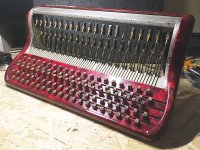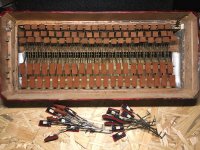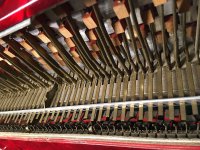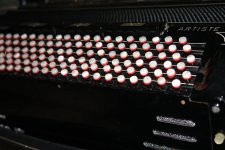nou
Member
Hi to you all!
A quick backstory: after almost 15 years of my adventures in concertina world, learning both how to play on them (on and off, so way, way less in terms of actual play practice), and how to build them (I made a 66b Hayden duet for myself - naive I thought it would be cheaper and faster, than to order one and wait 4 years of queue; how wrong I was ) I finally decided, I need a free reed instrument with full range and sound options - an accordion.
) I finally decided, I need a free reed instrument with full range and sound options - an accordion.
But then the first problem arose - which system. The target genres are modern "street" french music like La Rue Ketanou, Tiersenn and classical music. Besides Hayden concertina, I also learn to play on a Janko piano, so my first thought was to buy used piano accordion and rebuild the treble side to Janko layout. But as I mentioned earlier - I need a full range instrument, and my biggest gripe with piano/Janko is octave span. Also, while technically Janko is an isomorphic layout, C- and B- systems have more capabilities, being fully 2D arrays. Leaning more towards B-system, I went hunting. But the only affordable and compelling option was listed as C-system. Since I have no experience in neither, I decided to give it a go anyway expecting to re-sell it if I didn't like C system ergonomics/logic, and ended with this beauty, bought for 400$:
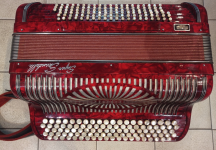

There are no markings besides the logo Super Scandalli, but thanks to this very forum I gather, that it's from '50. It's LMM, has two thumb on/off registers, for L and M+, and one bass register (with 5 voices), and to my great surprise, it was listed wrong - it's in B-system! The second surprise was discovering, that M reeds are brass - I vastly prefer the sound of brass or zinc reeds over aluminum, so I was now confident, that I'm keeping it. The third and last surprise was discovering, that contrary to my earlier experiences with Stradella, Belgian layout is both more intuitive and comfortable for me to play. I especially like the third bass row.
It is in really great shape for ~70 years old box. Exterior, woodwork and the bellows are pretty much unscathed and it had been renovated at least once during its lifetime, presumably in the last two decades judging by the valves and wax condition. However it is, as expected, unplayable as-is and requires a complete overhaul. Yes, yes, I'm perfectly aware, that this is not financially viable. However, as I mentioned, I know a thing or two about building free reed instruments, have all of the necessary tooling and most of the necessary supplies, and treat this project as more of an accordion construction workshop, that in the end will still provide me with a full range B-system instrument for less than the available alternatives.
Now besides the basic restoration, the goal here is to add third register to the treble side, to increase sound options from the current four to the full six. I especially miss the bassoon option. I would also like to have on/off registers for all of the bass voices, but this may prove difficult. However, adding one more combination should be viable.
So, here we go!
A quick backstory: after almost 15 years of my adventures in concertina world, learning both how to play on them (on and off, so way, way less in terms of actual play practice), and how to build them (I made a 66b Hayden duet for myself - naive I thought it would be cheaper and faster, than to order one and wait 4 years of queue; how wrong I was
But then the first problem arose - which system. The target genres are modern "street" french music like La Rue Ketanou, Tiersenn and classical music. Besides Hayden concertina, I also learn to play on a Janko piano, so my first thought was to buy used piano accordion and rebuild the treble side to Janko layout. But as I mentioned earlier - I need a full range instrument, and my biggest gripe with piano/Janko is octave span. Also, while technically Janko is an isomorphic layout, C- and B- systems have more capabilities, being fully 2D arrays. Leaning more towards B-system, I went hunting. But the only affordable and compelling option was listed as C-system. Since I have no experience in neither, I decided to give it a go anyway expecting to re-sell it if I didn't like C system ergonomics/logic, and ended with this beauty, bought for 400$:


There are no markings besides the logo Super Scandalli, but thanks to this very forum I gather, that it's from '50. It's LMM, has two thumb on/off registers, for L and M+, and one bass register (with 5 voices), and to my great surprise, it was listed wrong - it's in B-system! The second surprise was discovering, that M reeds are brass - I vastly prefer the sound of brass or zinc reeds over aluminum, so I was now confident, that I'm keeping it. The third and last surprise was discovering, that contrary to my earlier experiences with Stradella, Belgian layout is both more intuitive and comfortable for me to play. I especially like the third bass row.
It is in really great shape for ~70 years old box. Exterior, woodwork and the bellows are pretty much unscathed and it had been renovated at least once during its lifetime, presumably in the last two decades judging by the valves and wax condition. However it is, as expected, unplayable as-is and requires a complete overhaul. Yes, yes, I'm perfectly aware, that this is not financially viable. However, as I mentioned, I know a thing or two about building free reed instruments, have all of the necessary tooling and most of the necessary supplies, and treat this project as more of an accordion construction workshop, that in the end will still provide me with a full range B-system instrument for less than the available alternatives.
Now besides the basic restoration, the goal here is to add third register to the treble side, to increase sound options from the current four to the full six. I especially miss the bassoon option. I would also like to have on/off registers for all of the bass voices, but this may prove difficult. However, adding one more combination should be viable.
So, here we go!

